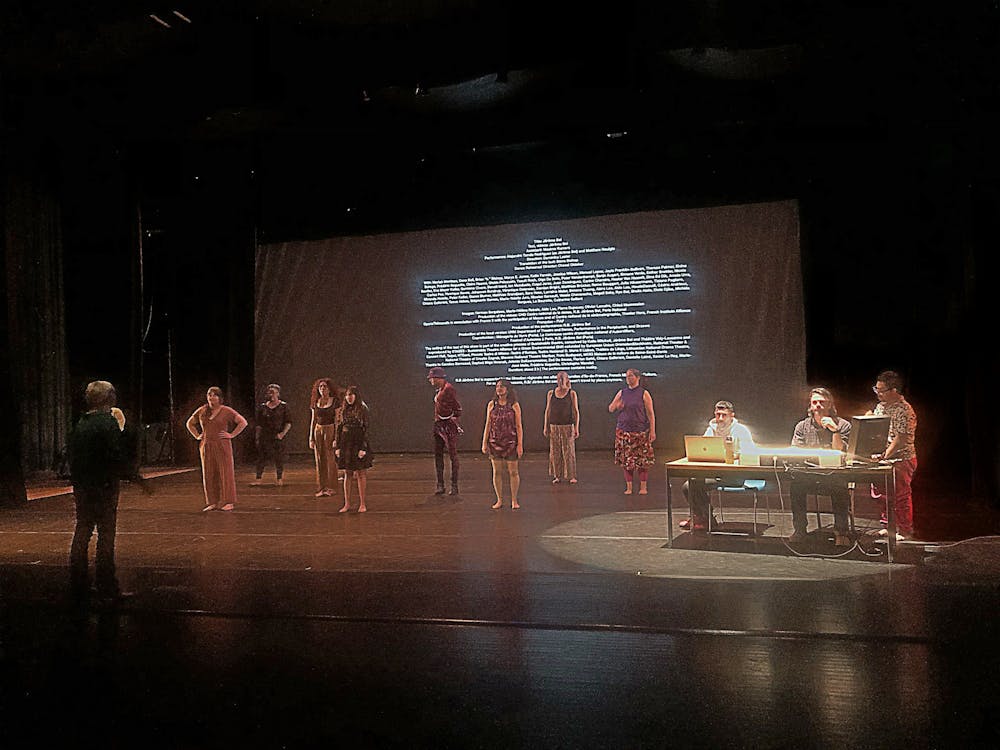There’s a line in “Jérôme Bel,” presented over the weekend by the University of New Mexico Department of Theatre and Dance, that says, “The most beautiful thing a performer can bring to their audience is their vulnerability.”
The piece, titled “Jérôme Bel” after the author, French contemporary choreographer, is directed by professor Dominika Laster and reenacted by UNM assistant professor of theater Alejandro Tomás Rodriguez. In the piece, Rodriguez (as Bel) presents a performance-lecture on works from the artist’s history of unique choreography.
After Bel stopped traveling, he extended an invitation to performance artists and theater-makers around the world to enact the piece, which he stylized as an “auto-bio-choreo-graphy.” Laster, who has followed Bel’s choreography and work in performance studies since graduate school, decided to bring the piece to UNM.
“I thought it would be a great pedagogical exercise and a great way to expose UNM students and faculty and community members to his work,” Laster said.
The lecture tracks Bel’s career from the ‘90s to the present, with video clips guided by Bel’s words, as spoken by Rodriguez.
“The idea is to not perform,” Rodriguez said. “The idea is to not become someone else, but rather find the limited liminal space between ‘doing Jérôme Bel’ and trying to incorporate small details or the way that he's relating with the text. So I tried to find in myself some sort of analogy when I'm reading, but not to make a character.”
As the piece acknowledges, Bel’s work, which pushes the boundaries of dance and performance, has garnered criticism from critics and audiences over the years. Examples of his controversial works include 2012’s “disabled theater” and 1995’s self-titled “jérôme bel.”
After the lecture, there was a short series of live performances by UNM community members, inspired by Bel’s work. This practice is inspired by 2015’s “gala,” in which the choreographer had a series of dancers at varying levels of skill and experience take turns choosing their own music and leading the entire ensemble in dance.
One of the lead dancers included Matthew Holguin, an actor and senior at La Cueva High School. Holguin choreographed and led the performance of his selected song; he joined the production on invitation from Laster after they met through Cheval Oldaker’s contact improvisation class.
Though much of the lecture is presented through video, the live component adds an aspect connective to audiences, Laster said.
“There's something immutable about liveness and having the experience of someone (telling) us the story in real life. Being in a group of people in a darkened room, we go on a journey together. It's very different from when I watched the piece, for example, on my own on my laptop for the first time. So I think there's something very special in that experience. We get to create community,” Laster said.
The loose follow-the-leader style of the finale allowed for the ensemble, comprised of actors of all skill levels, to find the joy in performance, performer and master of fine arts student Jessica Wilson said.
Get content from The Daily Lobo delivered to your inbox
“The point of this work is not precision,” Wilson said. “We get to witness someone creating whatever they feel like making in real time and we get to share that moment of focus and joy with them. There isn't any pressure to get it right like in a typical piece. Instead, the focus is more on finding and sharing in the essence of their movement.”
The piece was performed Friday night in the Elizabeth Waters Center for Dance and in Santa Fe on Saturday at Wise Fool New Mexico.
“We are not trying to perfect, the dancers are not trying to do it perfect, but they engage in the game and they dance. And so, because they are in this process of finding what the next step will be about, what is the next rhythm, the next change, it creates some transparency in the people. And that's very beautiful,” Rodriguez said.
Spenser Willden is the culture editor at the Daily Lobo. He can be reached at culture@dailylobo.com or on twitter @spenserwillden






